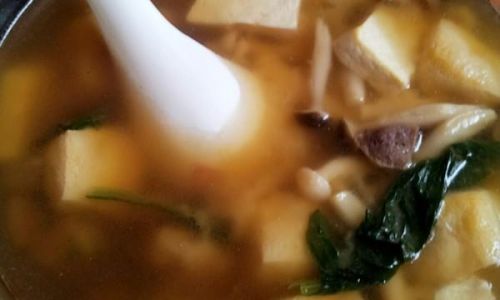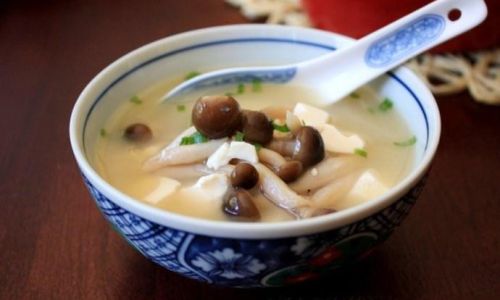Introduction: A Taste of Tradition
In the realm of Japanese cuisine, miso soup stands as a timeless staple, embodying the essence of simplicity, harmony, and deep-rooted tradition. This delicate broth, enriched with the umami-laden flavors of miso paste, offers a comforting warmth that transcends seasons and dietary preferences. Among the myriad variations of miso soup, the mushroom miso soup stands out for its earthy richness and sophisticated taste, making it a favorite among both home cooks and seasoned chefs.

Today, we embark on a culinary journey to explore the art of crafting the perfect mushroom miso soup. This dish is more than just a meal; it’s a celebration of ingredients, a testament to the skill of the preparer, and a gateway to understanding the intricate balance of Japanese flavors. As we delve into the preparation, we’ll uncover the secrets behind selecting the right mushrooms, the importance of using high-quality miso, and the delicate dance of temperatures that brings out the best in each ingredient.
Chapter 1: The Heart of the Matter: Understanding Miso
Before diving into the recipe, it’s crucial to understand the cornerstone of our soup – miso. Miso is a fermented soybean paste that has been a staple in Japanese diets for centuries. Its origins trace back to ancient China, but it was refined and perfected in Japan, where it became an integral part of daily meals.
Types of Miso:
-
Shiro (White) Miso: Made with a higher proportion of rice koji and aged for a shorter period, white miso is sweeter, lighter in color, and less salty. It’s ideal for summer dishes or those requiring a delicate flavor profile.
-
Aka (Red) Miso: Rich in color and flavor, red miso is fermented longer with more soybeans and less rice koji. It has a stronger, saltier taste and is perfect for colder weather dishes or those needing a robust flavor boost.
-
Awase (Mixed) Miso: A blend of white and red miso, awase miso offers a balanced flavor profile, making it versatile for various dishes.
For our mushroom miso soup, we recommend using either awase miso for a well-rounded flavor or red miso if you prefer a deeper, more intense taste. The choice will depend on your personal preference and the other ingredients you plan to incorporate.
Chapter 2: The Art of Mushroom Selection
Mushrooms are the soul of our soup, adding layers of earthy, umami-rich flavors that complement the miso perfectly. When selecting mushrooms for your soup, consider the following varieties for a harmonious blend of textures and tastes:
-
Shiitake Mushrooms: Known for their robust flavor and meaty texture, shiitakes are a staple in Japanese cuisine. Their umami-laden properties make them an excellent choice for miso soup.
-
Cremini Mushrooms: These are a variety of brown mushrooms with a slightly sweeter, nuttier flavor than white button mushrooms. They add depth and creaminess to the broth.
-
Maitake Mushrooms: Also known as “hen of the woods,” maitake mushrooms have a delicate, sweet flavor and a fan-like appearance. They are prized for their health benefits and unique texture.
-
Enoki Mushrooms: These long, thin mushrooms with a delicate flavor and tender texture are often used in Asian dishes. They add a visually appealing element to the soup.
When purchasing mushrooms, look for firm, dry caps with no signs of sliminess or discoloration. Freshness is key, as mushrooms can quickly lose their flavor and texture if not stored properly.

Chapter 3: Preparing the Ingredients
Now that we’ve selected our miso and mushrooms, let’s dive into the preparation process. This step-by-step guide will ensure that every ingredient is perfectly ready for the final assembly.
Cleaning Mushrooms:
- Shiitake Mushrooms: Remove the stems and gently wipe the caps with a damp cloth or paper towel. Avoid soaking them in water, as this can make them soggy and waterlogged.
- Cremini Mushrooms: Trim the stems and clean the caps similarly to shiitakes.
- Maitake Mushrooms: Separate the clusters into smaller pieces and gently brush off any dirt.
- Enoki Mushrooms: Trim the bottom of the stem cluster and separate the mushrooms into small bunches if desired.
Slicing and Dicing:
- Slice shiitakes and creminis into thin pieces to ensure they cook evenly and release their flavors into the broth.
- Maitake mushrooms can be torn into bite-sized pieces.
- Enoki mushrooms can be left in bunches or gently separated into individual strands.
Chapter 4: Crafting the Broth
The broth is the backbone of any miso soup, and its quality can make or break the dish. For our mushroom miso soup, we’ll create a simple yet flavorful dashi (Japanese stock) as the foundation.
Ingredients for Dashi:
- 6 cups water
- 1 piece (about 4 inches) of kombu (kelp)
- 1/4 cup bonito flakes (katsuobushi)
Instructions:
-
Preparing the Kombu: Wipe the kombu with a damp cloth to remove any surface dirt or salt. Do not soak it in water.
-
Simmering the Kombu: In a large pot, bring the water to a gentle simmer over medium-low heat. Add the kombu and let it simmer for about 10 minutes. The kombu will slowly release its umami-laden flavors into the water.
-
Adding Bonito Flakes: Remove the kombu from the pot (you can reserve it for other uses if desired). Increase the heat to medium and bring the water to a rolling boil. Add the bonito flakes and let them simmer for about 1 minute. The flakes will sink to the bottom and turn the broth a milky white color.
-
Straining the Dashi: Turn off the heat and let the bonito flakes settle for a minute. Carefully strain the broth through a fine-mesh sieve to remove any particles. Your dashi is now ready.
Chapter 5: Assembling the Soup
With our dashi prepared and mushrooms sliced, it’s time to bring everything together in a harmonious symphony of flavors.
Ingredients for Mushroom Miso Soup:

- Prepared dashi (from above)
- 4-5 shiitake mushrooms, thinly sliced
- 4-5 cremini mushrooms, thinly sliced
- 1 small maitake mushroom cluster, torn into pieces
- 1/2 cup enoki mushrooms, separated into bunches
- 1/4 cup miso paste (awase or red, based on preference)
- 2 tablespoons sake (optional, for added flavor)
- 2 tablespoons mirin (optional, for sweetness)
- 1-2 green onions, thinly sliced (for garnish)
- Seaweed (nori), cut into thin strips (for garnish, optional)
- Tofu cubes (optional, for added protein)
Instructions:
-
Heating the Dashi: In a medium pot, pour the prepared dashi and bring it to a gentle simmer over medium heat.
-
Cooking the Mushrooms: Add the shiitake and cremini mushrooms to the pot. Let them simmer for about 5 minutes, allowing their flavors to meld with the broth.
-
Adding Maitake and Enoki: Add the maitake and enoki mushrooms. Continue to simmer for another 3-4 minutes, until all the mushrooms are tender.
-
Preparing the Miso Mixture: In a small bowl, combine the miso paste with a ladle of the hot broth. Stir until the miso is fully dissolved. This step is crucial, as adding miso directly to boiling broth can destroy its delicate flavors and textures.
-
Tempering the Miso: Gradually pour the miso mixture back into the pot, stirring gently to avoid breaking up the mushrooms. Continue to simmer for another 1-2 minutes, but do not let the soup boil vigorously, as this can curdle the miso.
-
Adding Optional Flavors: If using, add sake and mirin to the pot. Stir well and let the flavors meld for another minute.
-
Tasting and Adjusting: Taste the soup and adjust the seasoning if necessary. Remember, miso paste is quite salty, so you may not need additional salt.
-
Serving: Ladle the soup into bowls. Garnish with thinly sliced green onions and seaweed strips. If desired, add a few cubes of tofu for added protein and texture.
Chapter 6: Serving and Enjoying
Your mushroom miso soup is now ready to be enjoyed. Serve it immediately while it’s still hot, as the flavors are most vibrant and the mushrooms at their tenderest. Pair it with a simple meal of steamed rice, grilled fish, or a light salad for a complete and satisfying Japanese-inspired dinner.
As






0 comments